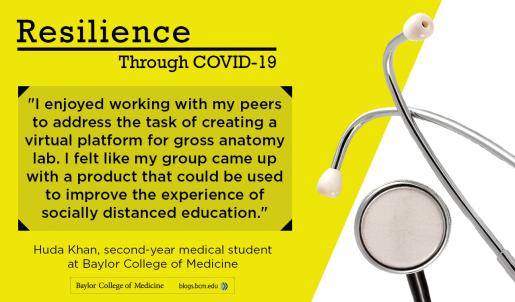Resilience Through COVID-19: Solving ‘Wicked Problems’
At the onset of the COVID-19 pandemic, medical students were thrown into a sea of uncertainty. Leading up to the cancellation of classes and emptying of campus, rumors and speculation filled the halls as students tried to make sense of what online learning meant at Baylor College of Medicine.
Each student’s unique situation precipitated ways to navigate their pandemic experience. Thus, the “Wicked Problems” elective was born.
A wicked problem is defined as “a social or cultural problem that is difficult or impossible to solve for as many as four reasons: incomplete or contradictory knowledge, the number of people and opinions involved, large economic burden, and the interconnected nature of these problems with other problems.”
In medical education, developing novel solutions to address wicked problems is not a simple fix. Traditionally, solutions focus on speed. However, design for impact must be methodical and rigorous, and there are many examples in which wicked problems may be addressed in medical education.
As administration worked tirelessly to transition to an online platform, the Wicked Problems course was created to receive valuable input from those affected by the shift: the learners themselves.
Importance of the student perspective
It had taken me three terms of medical school to perfect what I thought was my ideal study style when the pandemic disturbed that delicate balance. I, like many of my peers, had suggestions on how to improve the new socially distanced medical school experience.
The elective sparked my interest because it seemed to be a constructive way for students to present ideas to faculty.
One reason that student involvement is crucial to tackle educational challenges is that aside from the professors, students are the people closest to the material. This allows students to provide valuable, instant feedback on which instructional strategies are effective. Each new generation of students will inevitably bring to fruition novel ideas that faculty and even older students have not yet considered.
Training students to think through an educational design framework and express their solutions professionally will allow students to continually generate productive solutions, thus taking charge of their own education.
Identifying problems
The elective was taught as a blend of whole-group sessions punctuated by small-group discussion. Sessions were well-organized and presented material at an introductory level. Lecturers introduced a resource or educational design framework followed by examples of how the framework was implemented in real life.
This immediate application of new concepts to real-world situations was the most valuable part of the elective. Some of our tasks were lighthearted – we designed a study to find our professor the best route home in rush hour and created a model to determine the ideal chocolate chip cookie.
Tackling these more mundane problems gave us skills to tackle our wicked problem, an educational problem that each group selected during the first session.
Developing solutions
Before starting the course, I was ready to jump into brainstorming and outlining solutions. It was almost frustrating having to step back and define the problem, do research, determine an agenda, and outline goals before even beginning to discuss how to address the issue.
Through small group discussions and the examples given to us by our lecturers, I began to truly recognize the value and necessity of going through the entire process. Throughout the course, student groups addressed challenges, including how to teach and evaluate gross anatomy and neuroanatomy knowledge; how to teach, practice, and assess history-taking and physical exam skills; and how to maintain student engagement in a distanced environment.
I enjoyed working with my peers to address the task of creating a virtual platform for gross anatomy lab. As a group, we made recommendations on how to conduct the course.
Our ideas included orientation sessions for the students, a collection of new resources, and a variety of staggered virtual and in-person small-group interactions. Going through the educational design process before making suggestions allowed us to formulate them in a structured, organized, and implementable way.
I observed a few trends among the groups in the course:
- A focus on personalized learning. Teams advocated for a variety of virtual anatomy resources to be available to students since their access to cadavers would be limited.
- Novel usages of existing technology. Several groups suggested teaching gross anatomy through live sessions where students would have the opportunity to ask questions to their professors and teaching assistants in real time.
- The need for students to develop adaptability, flexibility, and resilience. While the COVID-19 pandemic underscored the need for these qualities, many groups addressed how in an ever-changing, often mentally taxing field like medicine, these characteristics are vital.
At the end of the four-week course, I felt like my group had come up with a product that could actually be used to help improve the experience of socially distanced education. I feel confident that I have acquired skills to solve educational “wicked problems” in the future, and I hope to get the opportunity to hone these skills.
-By Huda Khan, second-year medical student at Baylor College of Medicine. Zainub Abdullah, second-year medical student and Amelia Khoei, third-year medical student at Baylor, also contributed to this post.





